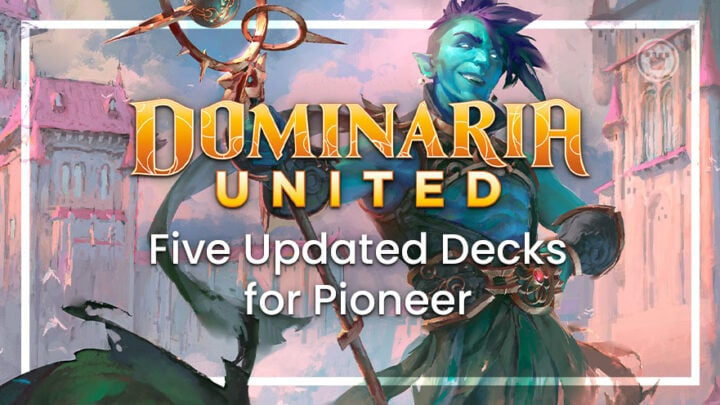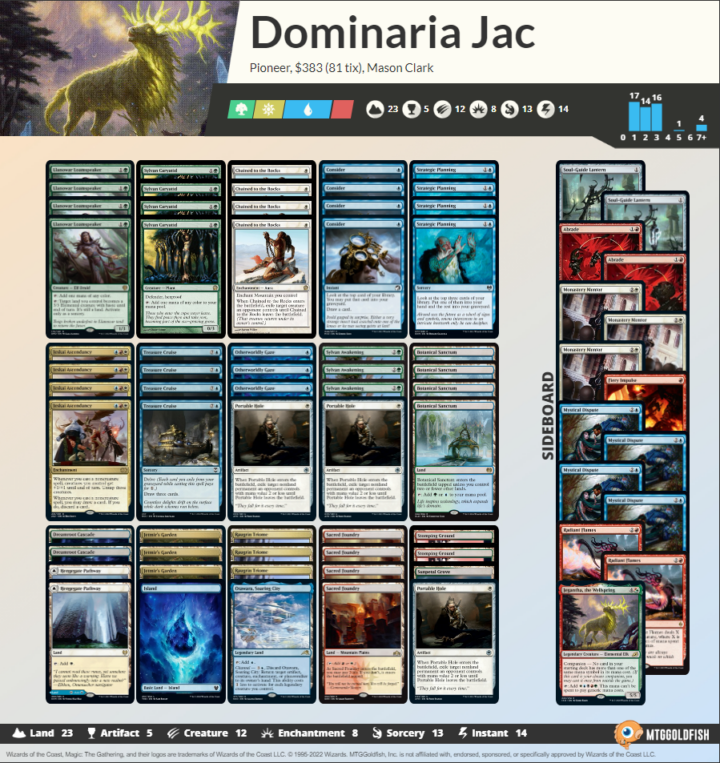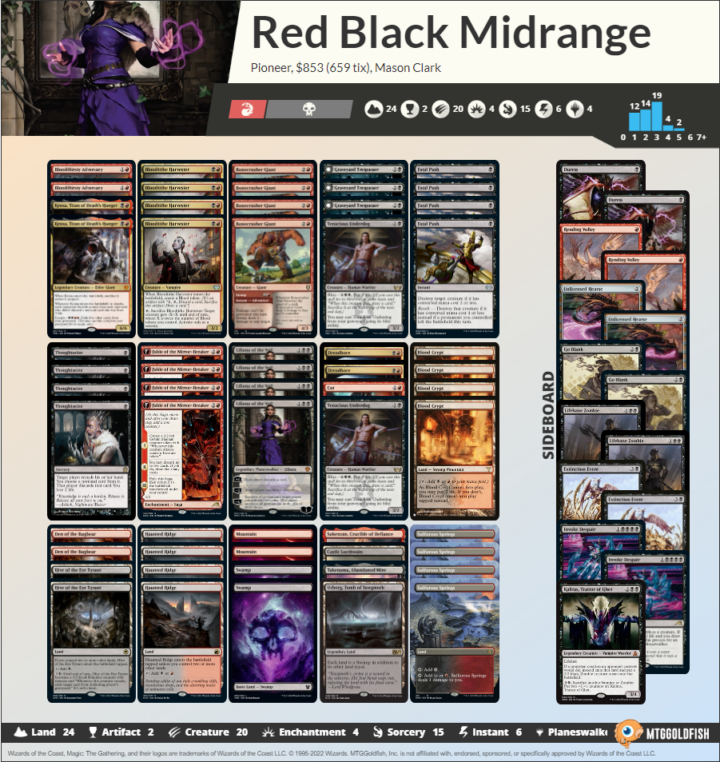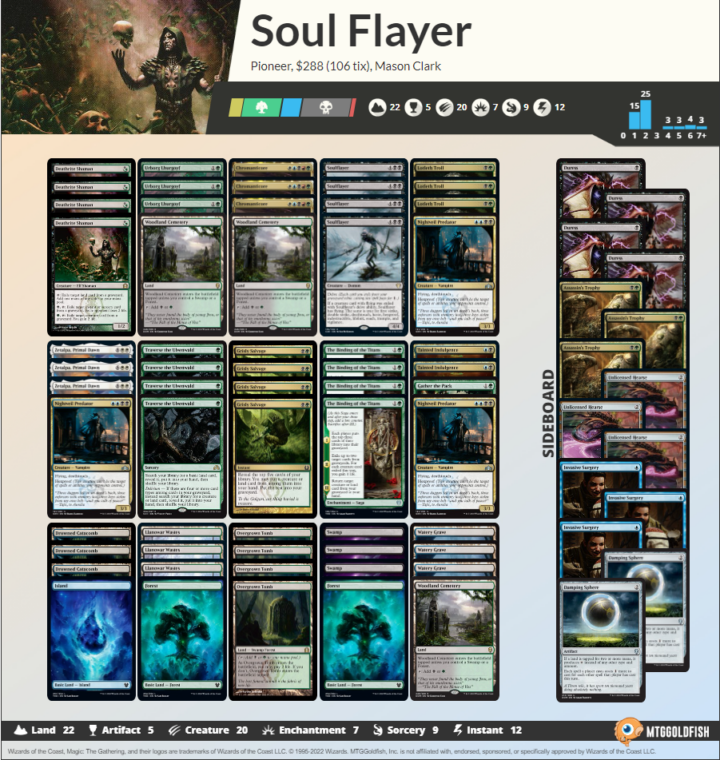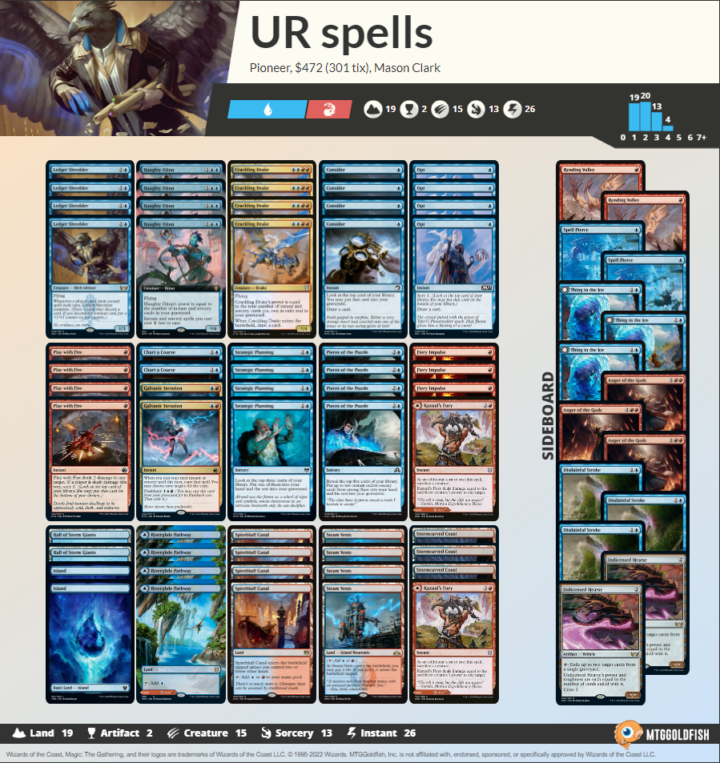To commemorate Dominaria United releasing next week in paper and this week on Magic Online, we are going over five decks featuring new cards for the Pioneer format. These archetypes range from familiar faces to possible new contenders, so they should prepare players for the new challenges ahead of them.
Jeskai Ascendancy
Jeskai Ascendency is one of the cards people have been trying to break since the Pioneer format began. The goal of this deck is to turn your lands into creatures before casting spells that will untap those lands and grow them at the same time.
This process creates more and more mana, draws you more and eventually pumps your board enough to swing in for a lethal attack. While this has been a fine strategy at times, it has never held a top place in any metagame.
That might all change thanks to Llanowar Loamspeaker. We touched on it in last week’s article, but having more ways to turn lands into creatures and enable our combo is huge. It doesn’t hurt that the card itself is also a fine, mana generating body on top of everything else. On the whole, this card is very appealing for Jeskai Ascendancy.
After all, this deck often loses to itself by not finding its pieces consistently enough. So while this doesn’t fix the finding-an-Ascendency-problem, it makes winning the game when you do have one much easier.
Rakdos Midrange
This has been a top deck in Pioneer for a while now, and it is currently fighting with Mono Green for supremacy in the format. However, Dominaria United has offered a big, helping hand for this archetype: Liliana of the Veil. This card is all about constraining the game to low resources, which is exactly what the Rakdos deck wants to do most.
Another huge get for this deck is Sulfurous Springs. Getting better untapped mana for your early turns is pivotal for decks that need to curve out. The pathways have been part of pioneer for a while now, and while fine, they are often not quite as good as the pain lands. So, for decks like this that rely on curving out it’s a big get.
Greasefang
While everyone jumped to Rakdos Midrange as the prime deck for LIliana of the Veil, I quickly thought of a different, recent favorite of mine — Abzan Greasefang. The Greasefang deck had about three flex slots that players could use to try various cards and fix matchups, but Lilian is an allstar in this role.
She lets us cut down on the game’s resources, which means beating a Greasefang is much harder. Plus, it’s a removal spell that buys you some time against aggressive decks. Those can sometimes be tricky matchups.
The Abzan Greasefang deck continues to impress in the face of everything but Karn, the Great Creator. While the Mono Green deck has been a top performer for a while now, it’s not the end of the world to have one matchup with a problematic card. And if the rest of the matchups look better post Lili, we could see players look to cards like Fracture or Assassins Trophy to overcome this challenge.
Soulflayer
This is a deck players have tried at various points in Pioneer to flash-in-the-pan levels of success. If you haven’t played against this archetype before, the whole goal is to set up a Soulflayer with many keywords and use it to kill your opponent over two turns. It’s a fairly ambitious but strangely potent strategy.
One of the hurdles in this deck has been its ability to execute a normal, fair game plan when Soulflayer isn’t an option. While you were able to “do the thing” fairly often by turn four, having no back up plan against some opponents was a limiting pain point. That issue with the deck has now been fixed.
Urborg Lhurgoyf is the newest addition to this deck, granting you a creature that can help set up our main game plan while also functioning as a great back up threat that quickly kills the opponent.
While there is some small friction between the Goyf and Soulflayer, I think ultimately having a fair beat down back up plan is worth the sometimes awkward shrinking of Goyf. I think if you get Soulflayer in play, you’re OK with losing a few points of power elsewhere.
Izzet Spells
I love playing Crackling Drake and flinging it at players. It’s been a guilty pleasure of mine for a long time now. At the same time, Arclight has been slipping in popularity and power as the Pioneer format adapts to that deck more and more.
So, this deck is moving away from casting a bunch of spells in a single turn and relying on having a graveyard. Instead, the focus is just on churning through our deck and interacting with the opponent while setting up big swings.
Haughty Djinn is the card that makes all of this possible as a game one strategy. This card is a fusion of Enigma Drake and Goblin Electromancer. This means that we are able to chain through draw spells like Pieces of the Puzzle and Strategic Planning very easily — and we can often be presenting attacks for as much as seven damage on turn four.
This change in dynamic from a casting three spells a turn to just trying to overwhelm your opponent allows for a more aggressive slant in game one. After that, your opponent’s normal sweet of hate spells won’t work as well since we have no delve cards in the deck. That means cards like Rest in Peace and Unlicensed Hearse are not nearly as big of an issue for this deck to tackle.
Flying has always been one of the best ways to win races against decks that are trying to gum the board up, and double spelling has always been one of the best things to do in Magic. This deck looks to take those truths and apply them in the modern day.
End step
This handful of decks is only the beginning. This set has so many exciting, new cards that players are just getting their hands on, so we will have to wait and see what bubbles to the top of the metagame.
Above all else, now is the time to explore and innovate! Don’t forget to maintain a pioneering spirit while brewing, and let me know on Twitter if you have any other unique ideas.

Mason Clark is a grinder in every corner of the game who has played at the pro level and on the SCG Tour with Team Nova. Whether he’s competing in Standard, Historic or Modern, Mason plays with one goal in mind: to be a better player than he was the day before. Check out his podcast, Constructed Criticism, and catch his streams on Twitch.

